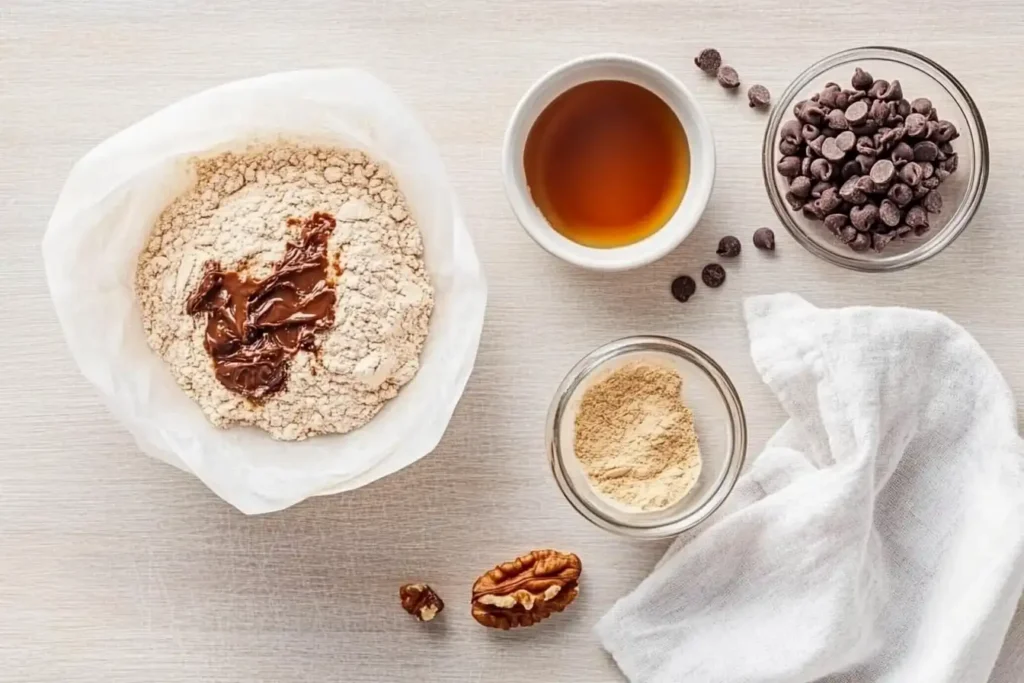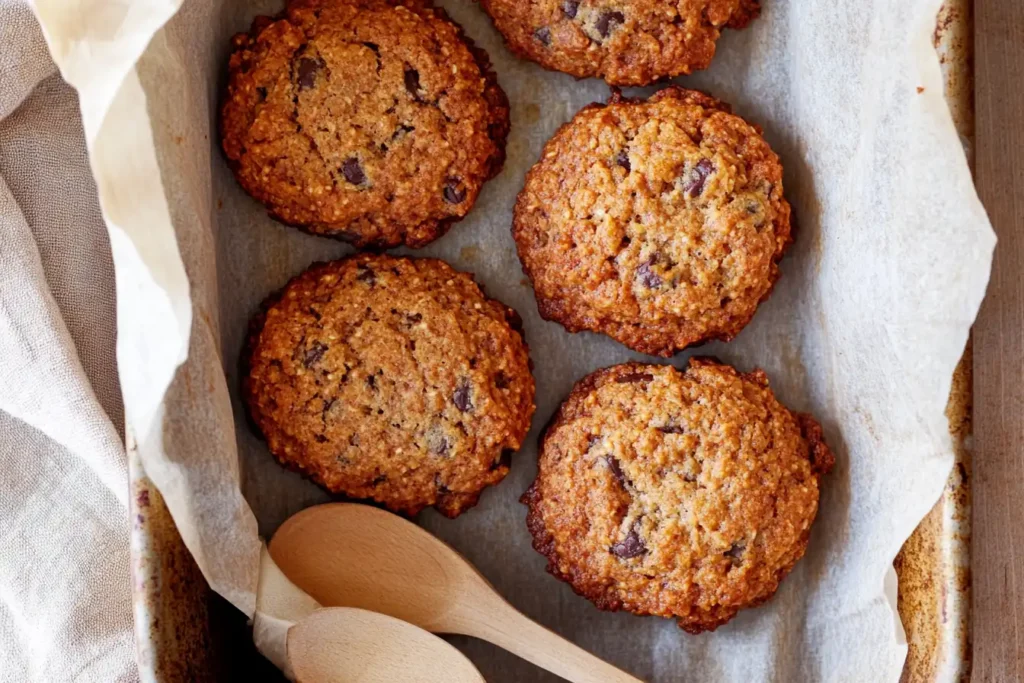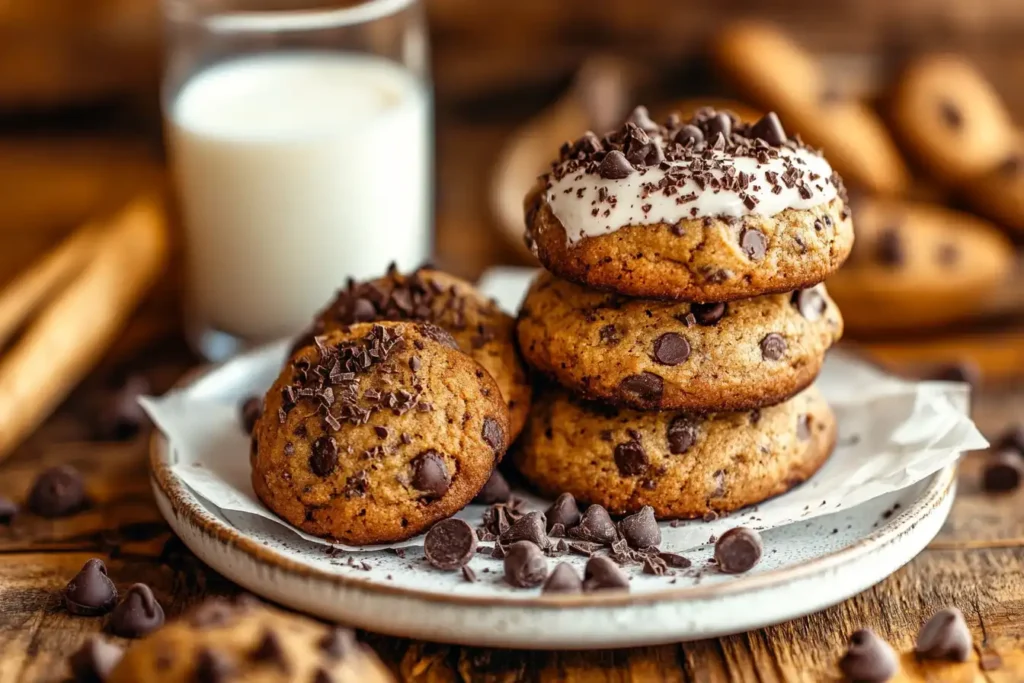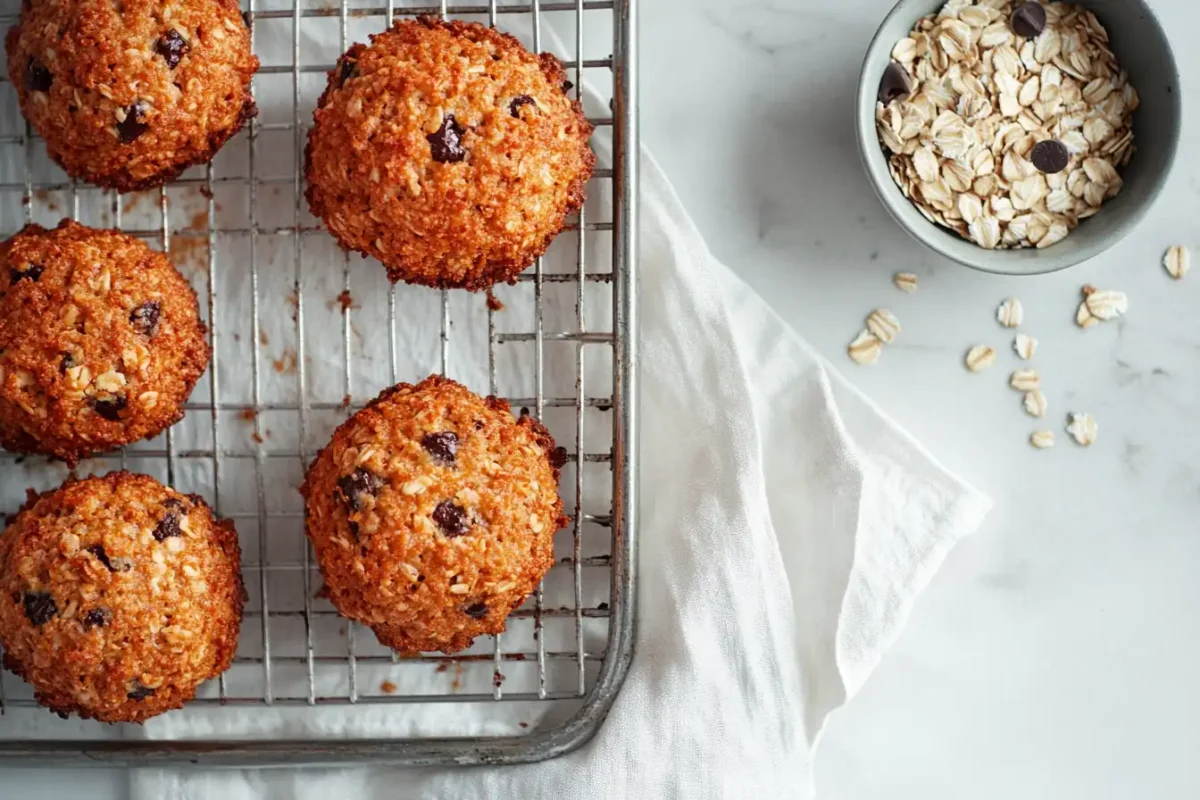Introduction to Protein Cookies
Protein cookies are a delightful fusion of traditional cookies and protein-packed ingredients. These baked goods are specially crafted to provide a higher amount of protein per serving compared to regular cookies, making them a fantastic snack for energy boosts, muscle recovery, or simply curbing hunger without guilt. By incorporating protein powders, nut butters, and other natural binders, protein cookies are both versatile and nutrient-dense.
Unlike store-bought snacks that often contain refined sugars and unhealthy additives, homemade protein cookies allow you to control every ingredient, ensuring a cleaner and healthier option. Whether you’re trying to meet your daily protein goals or craving something sweet yet nutritious, protein cookies tick all the right boxes.
Benefits of Protein Cookies
The benefits of protein cookies go beyond their delicious taste. These treats offer a range of advantages for anyone prioritizing their health:
- Boost Muscle Recovery: Protein is crucial for repairing muscle tissue after exercise. A high-protein cookie serves as the perfect post-workout snack.
- Curb Cravings: The combination of protein, fiber, and healthy fats keeps you full for longer, preventing overeating.
- Energy on the Go: These cookies are convenient and portable, making them ideal for busy lifestyles.
- Customizable Nutrition: By experimenting with ingredients, you can tailor protein cookies to be gluten-free, dairy-free, or low-carb, depending on your dietary needs.
Protein cookies aren’t just a snack—they’re a game-changer for anyone seeking healthier alternatives to sugar-laden desserts. Ready to whip up your batch? Keep reading!
Understanding Protein in Baking
The Role of Protein in Baking
Protein plays a transformative role in the art of baking, particularly when crafting protein cookies. Beyond being a key nutritional component, protein influences the texture, structure, and overall integrity of baked goods. When incorporated into cookies, protein works as a building block, binding ingredients together and creating a chewy, dense, or soft texture, depending on the recipe.
Unlike standard flour-based cookies that rely heavily on gluten for structure, protein powder-based recipes introduce a new dimension. Gluten-free protein powders like whey, pea, or collagen offer elasticity while keeping the recipe accessible for individuals with gluten sensitivities. This is why understanding the right balance of protein-rich ingredients is vital—too much protein can lead to dry or crumbly cookies, while too little might leave them flat or overly soft.
In essence, protein serves as the backbone of the cookie-making process. It gives your baked treats the resilience to hold together while also amplifying their nutritional value. Mastering its role unlocks a world of possibilities for making healthier desserts without compromising on flavor or texture.
How Protein Affects Cookie Texture and Flavor
Protein impacts both the texture and flavor of cookies in fascinating ways. For instance, a whey protein-based cookie often results in a chewy texture with a slightly creamy flavor, while plant-based proteins can create a denser consistency with a nuttier undertone. This variability gives bakers plenty of opportunities to experiment and cater to different taste preferences.
Moreover, the ratio of protein powder to other ingredients determines the cookie’s outcome. Too much protein can overpower the flavor, making cookies overly earthy or bitter. However, when paired with natural sweeteners like honey or maple syrup, the flavor is balanced, resulting in a harmonious blend of sweetness and nuttiness.
Understanding these effects ensures every bite of your protein-packed cookies is not just nutritious but utterly enjoyable.
Common Protein Sources Used in Cookies
When baking protein cookies, the choice of protein source significantly affects both taste and nutritional value. Here are some common types of protein used in cookies:
- Whey Protein: Known for its creamy texture and neutral flavor, whey protein is ideal for most recipes. It blends well with other ingredients and promotes a softer cookie texture.
- Plant-Based Proteins: Derived from sources like pea, rice, or hemp, these are perfect for vegan protein cookies. They offer a distinct nutty flavor and are a great option for those avoiding dairy.
- Collagen Protein: Loved for its ability to bind and add elasticity, collagen protein helps achieve a chewy cookie texture while offering joint and skin health benefits.
Other sources include almond flour, peanut butter, and even chia seeds, each contributing unique properties to the recipe. Choosing the right protein source isn’t just about nutrition—it’s also about creating a cookie that perfectly matches your desired flavor and texture.
Essential Ingredients for Protein Cookies
Key Ingredients in Protein Cookie Recipes
Crafting the perfect protein cookie recipe begins with choosing the right ingredients. The beauty of protein cookies lies in their versatility—you can tailor them to your taste, dietary preferences, and nutritional goals. While traditional cookies rely heavily on refined flour and sugars, protein cookies incorporate nutrient-dense alternatives that deliver both flavor and functionality.
Each ingredient in a protein cookie recipe plays a vital role, whether it’s adding texture, sweetness, or holding the dough together. From the type of protein powder you use to the choice of sweetener or binder, every decision matters. Below, we’ll break down the essential ingredients and their contributions to your cookies.
Protein Powders
The star of any protein cookie recipe, protein powders are a primary source of high-quality protein. They provide the structure and nutritional benefits that distinguish protein cookies from their traditional counterparts.
Whey Protein
Whey protein is a popular choice for its neutral flavor, creaminess, and smooth blending properties. It’s ideal for creating cookies with a soft, chewy texture that appeals to a wide audience.
Plant-Based Proteins
Derived from sources like peas, rice, or hemp, plant-based proteins are perfect for vegan-friendly cookies. They add a slightly nutty flavor and a denser consistency, making them a fantastic option for those avoiding dairy.
Collagen Protein
Collagen protein not only boosts the protein content but also contributes to elasticity and chewiness in cookies. Additionally, it’s celebrated for its skin, hair, and joint health benefits, making it a functional ingredient for wellness-focused treats.
Nut Butters
Nut butters, such as almond butter or peanut butter, are a must-have in protein cookies. They serve as a source of healthy fats and a natural binder that holds the dough together. The rich, creamy texture of nut butters enhances the mouthfeel of cookies, while their flavor pairs perfectly with chocolate, oats, and other popular ingredients. Opt for unsweetened varieties to keep the recipe healthier.
Natural Sweeteners
Skip the refined sugar—natural sweeteners like honey, maple syrup, or coconut sugar are healthier alternatives that add depth to the flavor. They strike a perfect balance between sweetness and nutritional value, ensuring your cookies satisfy your cravings without spiking your blood sugar levels.
Binding Agents
Binding agents are essential to achieving the right cookie texture. Ingredients like eggs, flaxseed meal, or chia seeds work to hold the dough together while contributing extra nutrition. For vegan recipes, flax or chia “eggs” (created by mixing seeds with water) are excellent substitutes that work just as effectively.
With these essential ingredients, you’re well on your way to creating protein cookies that are as delicious as they are nutritious!
Step-by-Step Protein Cookie Recipe
How to Make Protein Cookies at Home
Baking protein cookies at home is a rewarding process that lets you customize the flavor, texture, and nutritional profile to suit your needs. With just a handful of ingredients and a few simple steps, you can create a batch of delicious, protein-packed cookies that rival anything store-bought. Follow this step-by-step guide to make your own healthy treats with ease.
Understanding the nutritional content of your protein cookie recipe is crucial for maintaining a balanced diet. Here’s a breakdown of the approximate nutritional values for these cookies (per 100g):
| Nutrient | Amount (Per 100g) |
|---|---|
| Calories | 350 kcal |
| Protein | 20g |
| Carbohydrates | 25g |
| Sugar | 8g |
| Dietary Fiber | 5g |
| Fats | 12g |
| Saturated Fats | 3g |
| Sodium | 150mg |
| Calcium | 100mg |
| Iron | 2mg |
Ingredients Needed
To prepare protein cookies, you’ll need:
- 1 cup of almond flour
- 1/2 cup of whey or plant-based protein powder
- 1/2 cup of peanut butter (unsweetened)
- 1/3 cup of honey or maple syrup (natural sweetener)
- 1 egg (or flax egg for vegan recipes)
- 1/2 teaspoon of baking soda
- 1/4 cup of chocolate chips (optional, for added flavor)
These ingredients create a balanced blend of protein, healthy fats, and natural sweetness, ensuring your cookies are both tasty and nourishing.

Equipment Required
Here’s the equipment you’ll need for this recipe:
- A mixing bowl
- A whisk or hand mixer
- Measuring cups and spoons
- Baking sheet
- Parchment paper
These basic tools are enough to streamline the preparation process and keep cleanup simple.
Preparation Steps
- Preheat the Oven: Begin by preheating your oven to 350°F (175°C) and lining a baking sheet with parchment paper to prevent sticking.
- Mix the Dry Ingredients: In a large mixing bowl, combine the almond flour, protein powder, and baking soda. Whisk them together to ensure an even distribution.
- Blend the Wet Ingredients: In a separate bowl, mix the peanut butter, honey (or maple syrup), and egg until smooth. A hand mixer can make this step quicker and easier.
- Combine Wet and Dry Ingredients: Gradually fold the wet ingredients into the dry mixture. Stir until a dough forms. If the mixture feels too dry, add a teaspoon of water or milk to adjust the consistency.
- Add Mix-ins: If desired, fold in chocolate chips, nuts, or dried fruits to add extra flavor and texture.
Once your dough is ready, you’re all set to bake!
Baking Instructions
- Scoop the dough using a tablespoon and roll it into small balls. Flatten them slightly with the back of a spoon or your palm.
- Place the cookies on the lined baking sheet, leaving about 1-2 inches of space between them.
- Bake for 10–12 minutes or until the edges turn golden brown. Keep an eye on them to avoid overbaking, as this can make the cookies too dry.

Cooling and Storage Tips
Allow the cookies to cool on the baking sheet for about 5 minutes before transferring them to a wire rack to cool completely. Store your protein cookies in an airtight container at room temperature for up to 3 days, or refrigerate them to extend freshness for up to a week. For longer storage, freeze the cookies in a sealed bag for up to 3 months.
Now that your protein cookies are ready, it’s time to grab a glass of milk (or your favorite plant-based alternative) and enjoy your homemade, healthy treats!
Variations of Protein Cookies
Popular Protein Cookie Variations
One of the best things about protein cookie recipes is how customizable they are. Whether you prefer classic flavors, nutty richness, or a plant-based twist, there’s a protein cookie variation for everyone. These recipes allow you to enjoy variety while sticking to your health and fitness goals. Below are some popular variations you can try to spice up your protein cookie game.
Chocolate Chip Protein Cookies

Chocolate chip protein cookies are a timeless favorite for good reason. They combine the indulgent sweetness of chocolate chips with the nutritional benefits of high-protein ingredients. To make this variation, simply add 1/4 cup of semi-sweet chocolate chips to your base recipe. For extra decadence, sprinkle a few more chips on top before baking.
These cookies are perfect for satisfying sweet cravings while keeping you full and energized. To enhance the flavor, consider using a splash of vanilla extract or a pinch of sea salt for that bakery-style taste.
Peanut Butter Protein Cookies
If you’re a fan of peanut butter, this variation is a must-try. Replace almond flour with 1 cup of oat flour and use peanut butter as your main binding ingredient. This creates a rich, nutty flavor and a soft, chewy texture.
For an added protein boost, use peanut butter-flavored protein powder or top the cookies with crushed peanuts for a delightful crunch.These cookies are not only protein-packed but also incredibly satisfying for peanut butter lovers, similar to other high-protein peanut butter dishes.
Oatmeal Raisin Protein Cookies
For a wholesome and fiber-rich option, oatmeal raisin protein cookies are a fantastic choice. Add 1/2 cup of rolled oats and 1/4 cup of raisins to your base recipe. Oatmeal adds a hearty texture, while raisins bring natural sweetness and a chewy bite.
To elevate the flavor of your protein cookies, sprinkle in some cinnamon or nutmeg for a warm and aromatic touch. Additionally, this variation works wonderfully as a breakfast option or a satisfying mid-day snack, providing both nourishment and enjoyment. Not only that, it offers a balanced mix of protein, fiber, and healthy carbs, which are essential for maintaining energy throughout the day.
Furthermore, these cookies align perfectly with other healthy baked goods recipes, making them a versatile addition to your meal prep routine. As a result, you’ll have a wholesome treat that is both delicious and nutritious, suitable for any time of the day.
Vegan Protein Cookies
For a plant-based option, vegan protein cookies deliver both nutrition and deliciousness. Use plant-based protein powder and a flax or chia “egg” (1 tablespoon of flaxseed or chia seeds mixed with 3 tablespoons of water) in place of regular eggs.
Coconut oil or almond butter works well as a binder, while natural sweeteners like maple syrup provide just the right amount of sweetness. Add dairy-free chocolate chips or dried fruits for a bit of variety. These cookies are perfect for anyone following a vegan diet or avoiding animal-based ingredients.
With these variations, your protein cookie repertoire will never feel repetitive. Whether you prefer the indulgence of chocolate or the wholesomeness of oats, there’s a cookie here to suit your taste!
Tips for Baking Perfect Protein Cookies
Expert Tips for Baking Protein Cookies
Creating protein cookies that taste as good as they are nutritious requires a bit of finesse; however, the process is entirely manageable with the right approach. First and foremost, selecting the ideal protein powder is crucial, as it lays the foundation for both flavor and texture.
Furthermore, ensuring the perfect balance of ingredients helps achieve a texture that is soft yet chewy, which is often a challenge in high-protein baking. In addition, incorporating complementary flavors, such as vanilla, cocoa, or nut butter, can mask any overpowering taste from the protein powder.
Moreover, understanding the unique characteristics of baking with protein powder is essential, as it behaves differently from traditional flour. Therefore, precise measurements and adherence to proven techniques are vital.
By following these expert tips and experimenting patiently, you can confidently elevate your cookies to bakery-level quality, ensuring both taste and nutrition in every bite. Ultimately, mastering the art of protein-packed treats will leave you feeling accomplished and your cookies absolutely delicious.
Choosing the Right Protein Powder
The type of protein powder you choose can make or break your cookies. Whey protein, for instance, is known for its creamy texture and blends seamlessly into most recipes. Plant-based protein powders like pea or rice protein are excellent for vegan options but can produce a denser cookie if used in excess.
If you’re experimenting, it’s always a good idea to start with a small batch, as this allows you to test how the protein powder interacts with your other ingredients and adjust accordingly. Additionally, a helpful rule of thumb to ensure proper balance is to use about 1/2 to 3/4 cup of protein powder for every 1 cup of flour or its alternative, such as almond flour or oat flour. This approach not only maintains the structure of your cookies but also prevents them from becoming overly dry or dense, which is a common issue when too much protein powder is used. By taking these steps, you can achieve a more consistent and delicious result with every batch. Avoid using unflavored protein powders unless you plan to add natural sweeteners or spices.
Achieving Desired Texture and Consistency
Protein powders absorb more moisture than traditional flours, which means finding the right balance of wet and dry ingredients is critical. If your dough feels too dry, add a tablespoon of milk, water, or a plant-based alternative at a time until it reaches a pliable consistency.
For a chewy texture, use nut butters or coconut oil as a fat source. To achieve a crispier cookie, flatten the dough before baking and bake slightly longer. Experiment with baking times, as overbaking can quickly dry out protein cookies due to the high protein content.
Enhancing Flavor Profiles
Protein powders can sometimes have a bland or chalky taste, but adding flavor-enhancing ingredients will help balance this out. A splash of vanilla or almond extract can add depth, while spices like cinnamon, nutmeg, or cocoa powder bring warmth and richness.
For natural sweetness, opt for honey, maple syrup, or mashed bananas. Mix-ins like chocolate chips, chopped nuts, or dried fruits can also amplify the flavor while adding texture. Don’t forget a pinch of sea salt—it enhances sweetness and ties the flavors together beautifully.
By keeping these tips in mind, you’ll consistently bake protein cookies that are not only nutritious but also irresistibly delicious!
Frequently Asked Questions About Protein Cookie
Yes, protein cookies can be a healthy choice, especially when made with high-quality, nutrient-dense ingredients. Unlike traditional cookies, which are often packed with refined sugars and unhealthy fats, protein cookies focus on protein-rich ingredients such as whey protein, almond flour, and nut butters. These ingredients not only increase the protein content but also provide essential nutrients like healthy fats, fiber, and vitamins.
Protein cookies are particularly beneficial for those who want to build or repair muscles, manage weight, or avoid excessive sugar intake. However, store-bought options may include additives or excessive sugars, so it’s best to make your own at home for maximum control over the ingredients.
Protein powder can partially replace flour in cookie recipes, but it shouldn’t completely substitute all the flour. Flour provides structure and elasticity, which protein powder alone cannot replicate. If you use too much protein powder, your cookies may become dense, dry, or crumbly.
A good rule of thumb is to substitute up to 1/3 of the flour with protein powder. For example, in a recipe calling for 1 cup of flour, you can use 2/3 cup of flour and 1/3 cup of protein powder. Combining protein powder with gluten-free flours like almond or oat flour can also yield great results while maintaining the cookie’s structure and texture.
The healthiest cookies are those made with whole, minimally processed ingredients and tailored to meet your dietary needs. Some great examples include oatmeal protein cookies, which offer a mix of fiber and protein, or vegan protein cookies, made with plant-based protein powders and natural sweeteners like maple syrup.
Low-carb cookies made with almond flour or coconut flour and sugar alternatives like stevia are also excellent options for those watching their carb or sugar intake. Ultimately, the healthiest cookie is one that aligns with your nutrition goals and avoids refined sugars, hydrogenated oils, and artificial additives.
Conclusion Of Protein Cookie
Protein cookies are more than just a tasty treat—they’re a smart way to combine indulgence with nutrition. Whether you’re looking for a high-protein snack to fuel your fitness goals, a guilt-free dessert alternative, or a versatile recipe to experiment with, protein cookies deliver on all fronts.
With the right blend of protein powders, wholesome ingredients like almond flour and natural sweeteners, and a touch of creativity, you can craft cookies that are not only delicious but also aligned with your health goals. From the classic charm of chocolate chip protein cookies to vegan-friendly or oatmeal raisin options, the possibilities are endless.
By following the tips and techniques shared in this guide, you’ll be able to bake protein cookies with the perfect texture, flavor, and nutritional value. So, grab your mixing bowl, preheat your oven, and get ready to enjoy a snack that’s as satisfying as it is nutritious. Happy baking! 🍪

